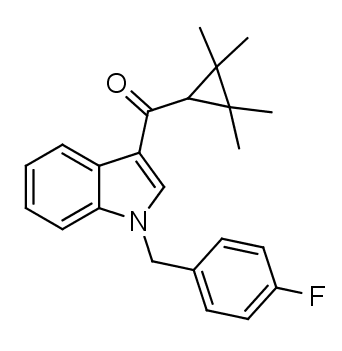Beautiful Plants For Your Interior
Summary
FUB-144, alternatively known as FUB-UR-144, belongs to the family of synthetic cannabinoids with an indole base. This compound is believed to exhibit vigorous agonistic activity toward the CB1 receptor and has been distributed on the internet as a designer drug. It is an analogue of UR-144 and XLR-11, differing in that the pentyl chain has been substituted with fluorobenzyl.
| Identifiers | |
|---|---|
| IUPAC name | |
| CAS Number | 2185863-15-2 |
|---|---|
| PubChem CID | 118796439 |
| ChemSpider | 30646792 |
| UNII | IWY4W66OKW |
| Chemical and physical data | |
| Formula | C23H24FNO |
| Molar mass | 349.449 g·mol−1 |

Legal status
In the United States, FUB-144 was subjected to a temporary emergency scheduling by the DEA in 2019, and on April 7, 2022, it was officially designated as a permanent Schedule I Controlled Substance.
Meanwhile, on March 24, 2015, Sweden’s public health agency recommended categorizing FUB-144 as a hazardous substance.
FAQ
1. What is FUB-144?
FUB-144 is a synthetic cannabinoid compound with an indole base. It is known for its activity as a potent agonist of the CB1 receptor and is often found in the context of designer drugs.
2. What are the effects of FUB-144?
The effects of FUB-144 can vary from person to person, but they are often similar to those of traditional cannabinoids. Users may experience altered perceptions, relaxation, and a sense of euphoria. However, it can also produce adverse effects, including anxiety and paranoia.
3. Is FUB-144 legal?
In many countries, FUB-144 is considered illegal due to its potential for misuse and health risks. The legal status can change, so it’s essential to stay updated on your local laws.
4. How is FUB-144 used?
FUB-144 is typically consumed by smoking or vaporization, similar to traditional cannabis products. However, it’s essential to note that the potency and effects can be significantly more potent, and the risk of adverse reactions is higher.
5. What are the risks associated with FUB-144?
FUB-144 and similar synthetic cannabinoids have been associated with adverse health effects, including cardiovascular issues, psychological distress, and even hospitalization in some cases. It’s considered a high-risk substance.
6. Can FUB-144 be detected in drug tests?
Yes, FUB-144 can be detected in drug tests, especially in screenings designed to identify synthetic cannabinoids. It is essential to be aware of the potential legal and professional consequences.
7. Is there any medical use for FUB-144?
No, FUB-144 does not have any recognized medical applications. It is solely used recreationally and, often, illicitly.
8. How can I stay safe when it comes to FUB-144?
The best way to stay safe is to avoid the use of FUB-144 and similar synthetic cannabinoids altogether. If you have used it and experienced adverse effects, seek medical help immediately. Stay informed about the legal status in your area, and always prioritize your health and well-being.
9. Where can I find more information about FUB-144?
You can find more information about FUB-144 through reliable sources such as government health agencies, research papers, and educational websites on substance abuse prevention and awareness.
References
- Reference: FUB-144. This information was sourced from the Southern Association of Forensic Scientists and was archived on 27th September 2015, with retrieval on 23rd July 2015.
- The Federal Register highlights the temporary placement of substances, including FUB-144, into Schedule I. This decision was made to control their distribution and use due to safety concerns.
- Furthermore, the Federal Register, in its 87th volume, 67th issue, dated 7th April 2022, officially placed substances like FUB-144 in Schedule I, designating them as controlled substances.
- In Sweden, the public health authority, Folkhälsomyndigheten, proposed the classification of several substances, including FUB-144, as narcotics or hazardous substances. This recommendation was retrieved on 23rd July 2015.